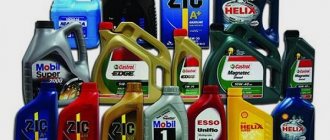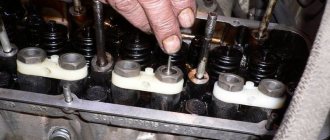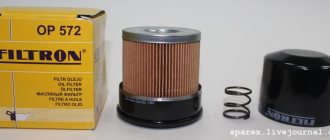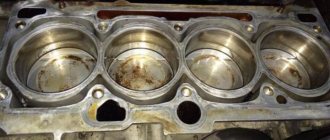Car enthusiasts often encounter the problem that the engine oil quickly turns black. And without doubt, they claim that this occurs as a result of the use of low-quality lubricant. But before saying this, you should understand the reasons for this phenomenon.
Mythical reasons
- The oil level in the engine was not checked in time. It can become darker only if a low-quality lubricant is used. If there is little lubricant left, the automation on the dashboard will report this. By pouring an additional portion of high-quality oil, you can prevent harmful consequences, and the lubricant will not darken.
- Poor quality fuel was added. When using it, some changes in the physical and chemical parameters of the lubricant are possible, but this does not lead to a change in its color.
- Water or antifreeze has entered the engine oil. Water always penetrates into the lubricant in small quantities. It is released from moist air in the engine cylinders or enters in the form of coolant if the cooling system is not tightly sealed. By its presence, water affects the pressure of the lubricant, but not its color. And when it completely evaporates, the oil pressure returns to normal. The presence of antifreeze affects the viscosity and acid-base indicators, but also does not lead to darkening.
As you can see, the above situations do not affect the color of the lubricant.
Valid reasons
The first reason, paradoxically, lies in the oil itself. Modern motor lubricants contain a whole package of additives that have cleaning and detergent properties. They are necessary to extend the life of the engine. Their action can be in different directions: to reduce friction, to change the properties of the oil at different temperatures, and also to regulate alkali. Alkali dissolves various contaminants and deposits in the engine and neutralizes acids. Then, when replacing the lubricant, all these elements are merged together with the waste fluid. But if the engine oil does not have the required amount of alkaline additives, dirt accumulates inside the engine. This leads to the fact that the lubricant cannot flow freely, and the motor begins to run dry. Heavy deposits envelop the engine housing and prevent heat from escaping, which threatens overheating and destruction of its parts. This is why it is so important to choose the right and suitable lubricant.
Similar consequences arise when using high-quality lubricant with a sufficient amount of alkaline additives, if it is not changed on time. After a certain time, the alkaline additive begins to age; the more dirty the engine is, the faster this happens, which contributes to the deposition of contaminants.
The second reason why the oil turns black is engine overheating. The lubricant was selected incorrectly in viscosity, the engine was operated at high speeds, and all this led to boiling of the lubricant. As a result, it not only darkened, but turned into a black thick substance, similar in consistency to fuel oil. This is determined by the oil dipstick. After wiping it with a rag, you can see black stains remaining on it - this indicates that the oil is burning. The main reason may be wear of the piston group. There may be gasoline left in the engine cylinders that was not burned during the process, and it gets into the lubricant. There is a change in its composition; it can no longer fully perform its functions. This leads to increased fuel consumption. Engine power decreases, and the oil pump may generally fail.
Oil darkening process ↑
It’s worth clarifying right away that normal high-quality oil should change its color. If the lubricant remains clean after prolonged use, it should be changed immediately. She can't cope with her functions. Such a lubricant product does not have a sufficient amount of additives or is diluted with various impurities.
The darker color of the oil is explained by the fact that during operation it circulates in a closed circle of the system. From the engine crater, the oil pump supplies it through channels to lubricate engine parts. The waste is removed, and the remaining oil returns to the engine crankcase. As it moves, it not only lubricates the parts, but also cleans their surfaces of various contaminants; these inclusions are deposited in it and change the color of the lubricant. This is an indicator of the effective operation of the lubricant.
If after a long period of use the oil remains clear, then this means that it is not doing its job, you should choose a different brand of product. And here you shouldn’t be afraid of how quickly the next lubricant will darken. She has to wash away all the deposits of accumulated deposits left over from the time that was lost when using low-quality or low-alkaline lubricant.
It should be noted that when switching to a lubricant with a high alkali level, the darkening of the oil will occur quickly. More alkaline additives work more thoroughly, breaking down old deposits and carbon deposits.
Engine oil darkens
Let's start with the lubricant itself. It is well understood that any motor oil is a mineral, synthetic or semi-synthetic base, which also contains a package of active additives. The indicated additives allow you to comprehensively improve various operational properties of the lubricant: reduce friction losses, stabilize temperature characteristics, extend the service life of the oil and slow down its aging, provide a cleaning effect, etc.
In the list of chemical additives to the base, a separate space is occupied by the alkaline number of a particular motor oil. In other words, the lubricant must contain alkali. The main task of this additive is to neutralize acids that form in the internal combustion engine during operation of the unit and then enter the lubrication system. Alkaline additives also intensively combat the appearance of deposits in the engine, wash away carbon deposits, coke, etc. To put it simply, the alkali in motor oil protects against oxidation and improves cleaning properties, allowing you to keep the inside of the unit clean.
It turns out that the ability of the oil to wash away contaminants will directly depend on the alkaline number. If we take this feature into account, then the widespread statement that high-quality motor oil does not actually have to darken in the first 3-5 thousand kilometers after replacement is a profound misconception. Typically, drivers who dealt with similar products 15-20 years ago are accustomed to assessing the properties of oil only by the rate of darkening. The fact is that in those years there were fewer additives and high-quality oil differed noticeably from the most accessible analogues in terms of the rate of contamination.
To put it simply, blackening of the oil was one of the main characteristics for changing it. A cheap lubricant could begin to darken after 400-800 km, while the most expensive options remained unstained for 2-3 thousand km, then gradually darkened by 5 thousand km. and then they turned black. Note that the color of the lubricant changed not as a result of the additives, but taking into account the parameters of the base oil. Now the situation has completely changed, because modern motor oils contain a huge amount of active additives.
Darkening of the oil indicates that the lubricant is holding and binding chemical components, deposits, etc. It turns out that acids do not have contact with parts, corrosion slows down and engine wear is minimized. During the process of replacing the lubricant, contaminants are combined with the used oil and do not settle on the surfaces of the parts. In other words, everything turns out exactly the opposite - if the oil does not turn black for a long time, then it does not wash or clean the engine, and does not provide reliable protection against harmful products. The long-term transparency and purity of the oil indicates that the lubricant is simply not capable of performing cleaning functions.
It is also useful to know that if there are not enough alkaline additives in the lubricant, then if the service replacement interval is exceeded, the engine will be subject to intense contamination and accumulation of deposits. In a number of different cases, the indicated contamination leads to a decrease in the throughput of the lubrication system channels, as a result of which the pressure in the system decreases, the lubricant is supplied to the loaded friction pairs in an insufficient volume, oil starvation and increased wear of the unit occurs.
Along with this, the temperature regime is disrupted at the interface points, and an increase in the friction force leads to overheating. Also, clogging of the oil system channels does not allow the circulating lubricant to fully ensure heat removal. Ultimately, damage to internal combustion engine parts occurs, crankshaft connecting rods or main bearings rotate, rockers fail, hydraulic compensators become clogged, etc. Specifically, to effectively counteract and prevent possible consequences, manufacturers add alkaline additives in a balanced manner. Let us add that immediately after the freshest lubricant enters the engine, the active work of the additive begins, in other words, the aging of the lubricant occurs. With mileage, the additive gradually loses its characteristics, the degree of protection of the engine from acids and deposits worsens, which is the reason for the next oil change.
It turns out that the service life of a modern lubricant is determined not by color, but by how long the alkaline detergent additive will remain in working condition. This highlight is one of the main reasons why the lubricant must be changed taking into account strictly defined intervals (on average, 10-15 thousand km in the CIS, which depends on the properties of the fuel). It becomes clear that oil is intended not only for lubrication, but also for cleaning. For this reason, its darkening during operation can be considered completely common.
Note that the lubricant darkens especially quickly in engines that were initially contaminated. In other words, darkening means that the oil is intensively washing the engine. Given this fact, the purity of the oil should be more alarming, in other words, when its color does not actually change with mileage. This may indicate that the lubricant has low cleaning ability and the engine is not cleaned.
For better understanding, it is enough to remember the individual characteristics of the lubrication system. Engine oil is pumped from the engine crankcase using an oil pump, then circulates through separate channels. The lubricant protects parts from dry friction, while at the same time carbon deposits and deposits are washed away, which then enter the crankcase. It is also necessary to take into account the highest temperatures at which the oil operates. As a result, the color of the material uniformly changes to the most black and this happens in a short period of time.
How quickly should the oil darken?
Why do lubricants darken at different rates? Several factors may influence this:
- fuel quality and consumption;
- engine cleanliness before using the selected oil;
- machine operating conditions;
- amount of alkaline additives.
The rate of darkening of the lubricant is directly related to the quality of the fuel. The use of low-quality fuel entails the formation of a large amount of waste, which, when broken down, settles in the oil, changing its color. The more there are, the faster this happens.
If the lubricant does not work properly, a lot of deposits (carbon deposits, slag, contaminants) accumulate in the engine. The new lubricant will begin to wash away all previously missed contaminants. That is why its aging will occur faster than the previous one. After using “working” oil, particles of decay products may accumulate on the filter device, so it is better to replace it. It is recommended to replace the filter throughout the life of the selected lubricant, before each replacement, to prevent the return of these particles.
Severe operating conditions of the car also affect the condition of the lubricant. These conditions include stop-and-go travel or normal city driving. During such routes, the engine does not have time to fully warm up and sometimes idles. In these cases, it makes sense to shorten oil change intervals to save the engine.
You should not resort to cleaning the engine with aggressive additives in large quantities. If they get into the lubricant, unpredictable chemical reactions can occur, which are best avoided. Flushing products have a lower viscosity than working lubricants; their presence can affect engine wear. For older engines, it is necessary to carefully select the amount of additives. After all, the more of them, the higher the cleaning ability of the lubricant, and they can wash away too old deposits that can clog the oil line and cause engine failure.
If the oil quickly darkens and is not replaced, what consequences can this lead to? Naturally, there will be no immediate damage. Modern types of lubricants dissolve various types of inclusions in themselves, continue to work and protect the engine throughout its service life, until the next replacement. If rapid darkening of the oil is detected, it should be replaced without maintaining the interval between replacements. And at the same time, find out the reasons for changes in its properties in order to protect yourself in the future. Motor oil is a valuable source of information about the overall condition of the vehicle.
Foaming: what's the problem?
The formation of air bubbles can lead to various negative consequences:
- Reducing the viscosity of the lubricant composition;
- Slow removal of thermal energy, due to which the parts and components of the car will not be properly lubricated. The oil in the system moves through special channels of small diameter, and in order to lubricate the engine, high pressure must be maintained in them;
- Lack of proper cooling of power unit parts, leading to overheating;
- Friction between engine parts increases, which leads to their rapid wear. In the most advanced cases, this can lead to water hammer and major engine repairs.
The emulsion in the engine harms all its parts
Motor oil can foam for several reasons:
- Penetration of antifreeze into the lubrication system of transport due to damage to the gasket between the cylinder block and its head;
- Water entering the lubricant, which leads to a change in its chemical composition and the formation of an oil emulsion;
- Incompatibility of lubricants. When changing oil, it is impossible to completely drain the old oil, which can cause it to mix with the new one.
Depressurization of the cooling system
The reason for the appearance of foam in this case is the mixing of oil and antifreeze. In most cases, this occurs due to defects in the gasket located under the cylinder block cover. Antifreeze can mix with engine oil if there are defects in the parts. Cracks form in them due to metal fatigue or prolonged exposure to high temperatures.
It is not always possible to find the coolant leak area
An antifreeze leak is easy to diagnose: just evaluate the smoke from the exhaust pipe. To do this, the engine idles for 10–15 minutes, after which the exhaust pipe is covered with a white sheet of paper. The sheet is thoroughly dried and checked for gasoline or oil stains. We can talk about a seal failure if there are no traces on the dry paper. This can only be eliminated by contacting a service center, since it is almost impossible to find an antifreeze leak on your own.
The color of exhaust smoke may be a diagnostic sign
Various motor oils
Foaming is typical for mixing two oils that differ in composition and properties. This is mainly caused by mixing synthetics and mineral oil. This happens due to the difference in the structure of the two types of lubricating fluids: in their properties, mineral oils are inferior to synthetic oils, which are formed as a result of catalytic synthesis reactions and the structure of which includes molecules of the same size, located at the same distance from each other. Mixing two different types of lubricant leads to the formation of sediment, which, circulating in the engine, forms air bubbles. The only way to eliminate foaming is to use motor oil of the same type and preferably the same brand.
The difference in the structure of synthetic and mineral oils
Condensate
When water gets into the engine or its parts, the latter mixes with the oil, forming an oil emulsion. It does not have a negative effect and does not cause malfunctions, but it indicates low-quality oil. Most often, an emulsion is formed in the winter season: a poorly heated car leads to condensation settling on the engine. Eliminating moisture formation is simple: you need to thoroughly warm up the car before each trip in the cold season.
The formation of condensation on a car engine is not a dangerous phenomenon.
Change in consistency
Engine oil thickening is the most dangerous problem. The consistency of the lubricant may resemble condensed milk, solid oil or even plasticine, the latter leading to negative consequences for the car:
- The car engine starts poorly and stops responding to pressing the accelerator pedal. At the same time, the pressure indicator on the dashboard is constantly lit;
- The engine connecting rods can break away from the pistons and pierce the wall of the cylinder block, which disables the entire engine.
Article on the topic: Polishing the bumper with your own hands
Changing the consistency of engine oil is extremely dangerous for the engine.
The exact reasons for the change in oil consistency have not been identified, but there are several basic assumptions:
- Mixing engine oil with water or coolant, resulting in a Shell effect. It is named so because experts from this particular company discovered in the 40s the presence of traces of antifreeze and water in thickened oil. It is worth noting right away that not all oils will change consistency even under similar conditions, however, the presence of water and antifreeze in the composition is a possible reason for the thickening of the lubricant;
- Low quality fuel. According to the theory, the combustion products of such gasoline can mix with the oil, reacting with additives, which causes thickening. It is worth noting right away that this reason is one of the most dubious and is still in question. Low-quality fuel is unlikely to have a strong effect on the oil: it enters the crankcase in minimal quantities and does not stay there for long, since the evaporation temperature of gasoline is lower than that of oil. In addition, mixing fuel and oil leads to a decrease in the viscosity of the latter, and not to its increase. In addition, changes in lubricant consistency also damage diesel engines;
- Human factor. A common reason is associated with pouring low-quality lubricant or a composition that has nothing to do with oil.
Conclusions ↑
1. A change in oil color indicates the following:
- darkened - everything works fine, the engine is safe;
- light - the selected lubricant does not perform its functions, it needs to be replaced;
- black - indicates a breakdown and the need for vehicle diagnostics.
2. The rate at which the oil darkens does not affect its protective and lubricating functions, but it is better to replace it before the due date.
3. A high-quality, high-alkaline lubricant product has short replacement intervals and must be used carefully, especially for older engines.
Recommendations ↑
- Lubricants should only be purchased in specialized stores. It is better to come to the scheduled technical inspection with your own oil, having first checked whether it produces sediment.
- Check the level and condition of the lubricant using the oil dipstick.
- You can periodically check the condition of the oil using the “drop test” method. To do this, you will need porous paper (any kind of paper will do, even a piece of newspaper). After the engine has cooled, you need to drip some lubricant from the oil dipstick onto the paper. Normal oil should spread across the paper, forming circles. But if it forms a thick black drop, then it needs urgent replacement.
← Previous post
Next entry →
Consequences
There is an opinion among domestic motorists that if the engine oil has become dark, then it has already exhausted its service life and needs to be changed urgently. Is it so? In part, yes, but this fact cannot be stated with certainty. Next, point by point, we will consider the possible consequences of the fact that the MM quickly turns black or becomes dark.
So, the lack of alkaline number is the basis of the consumable. If the motor fluid darkens precisely for this reason, then it is really better to replace it. If there is a lack of alkali in the structure of the lubricant, the vehicle’s engine will become more clogged with deposits and sediment, and this certainly will not lead to anything good:
- Firstly, if the engine is completely clogged with deposits that form as a result of carbon deposits, then you are guaranteed increased fuel consumption. When deposits appear, engine power will be significantly increased, which contributes to greater gasoline consumption by the vehicle. This is a fact and you can’t argue with it. In practice, if there are deposits inside the engine, fuel consumption can increase by 1-2 liters.
- Secondly, a major overhaul of the motor may be required. If the car operates for a long time with an increased level of carbon deposits in the engine, and the engine is not washed when changing the oil, then keep in mind that over time your “iron horse” will need major repairs. This will cost the car owner a lot of money.
Black carbon deposits on the internal walls of an internal combustion engine are a consequence of regular use of low-quality motor oil.
The entry of combustion and oxidation products into the engine. Of course, this will also not turn out to be anything good for the car owner. After all, MM turns black precisely for this reason, and not because of the poor performance of the substance itself, so replacing the lubricant alone is not enough. If you notice that the MM has turned black, but do not know why, and after its next replacement the consumable material has darkened again, then it makes sense to disassemble the power unit.
To do this, you will need to remove at least the cylinder head. If obvious wear of the cylinder-piston group is visible, then it is better not to delay the repair, otherwise this may result not only in a major overhaul, but also in a complete replacement of the power unit.
Poor quality MM. This may also be the reason why the consumable fluid darkens during operation. The disgusting quality of some types of motor fluids can lead to clogging of the engine with deposits and wear products. Wear products, in fact, also do not appear out of nowhere - these are engine parts, or rather their top layer. Regular use of such material will lead to even worse consequences.
An ideally clean engine - this is achieved by regularly flushing the internal combustion engine and using exclusively high-quality consumables
Good MM. This may sound counterintuitive, but even the high quality of a consumable can be the reason why it quickly turns black. The high operating temperature of the power unit, reaching 100-120 degrees, allows the engine fluid not only to well lubricate the internal components of the engine, but also to remove carbon deposits from them.
For this reason it darkens. Here we return to the myth that “if the oil has darkened, then it’s time to change it.” As domestic auto repairmen say: “that’s how oil works.” So darkening of the MM after some time of operation may not have any consequences. It will be much worse if throughout its service life it has not changed color and remains the same light as it was when poured. In this case, you will need to think about changing the MM.











